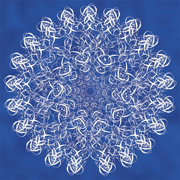Formal Aspects

Symmetry is when visual elements/objects or their representations have the exact shape or form when they are on the opposite sides of a dividing line or plane or about a center or an axis.

A visual element/object or its representation can be symmetrical within itself.

And it can also be symmetrical when visual elements/objects or their representations are repeated around the asymmetrical axis.

Using principles of symmetry, elements can be repeated to create interesting patterns.

Types of Symmetry - Reflection:
Reflection symmetry is when visual elements/objects or their representations are reflected across an axis. Reflection symmetry can occur in vertical, horizontal, diagonal or in any other direction.

Types of Symmetry - Rotational:
Rotational symmetry is when visual elements/objects or their representations are rotated around a point. Rotational symmetry can occur as revolving, radial and spiral.

Types of Symmetry - Translational:
Translational symmetry is when visual elements/objects or their representations are repeated by shifting or sliding its position. The shifting or sliding can occur in vertical, horizontal, diagonal or in any other direction. Shown above are examples of translational symmetry along with reflection.
Semantic Aspects

Symmetry creates visual balance - by the division of the visual element into equal halves around an axis. An element/object or its representation that is visually balanced in turn denotes harmony and unity.

Many objects in nature display symmetry - you can find this in humans, animals, leaves, and flowers.

There seems to be a unifying connection between the idea of symmetry and the workings of nature, the structure of living beings, mathematics, pattern making, music and poetry. We find instances of recurrence, recycling, rhythms and balance.
Practical Aspects

Many human created objects are made symmetrical. Examples of these are patterns, pottery, symbols, vehicles, buildings, and gardens.

